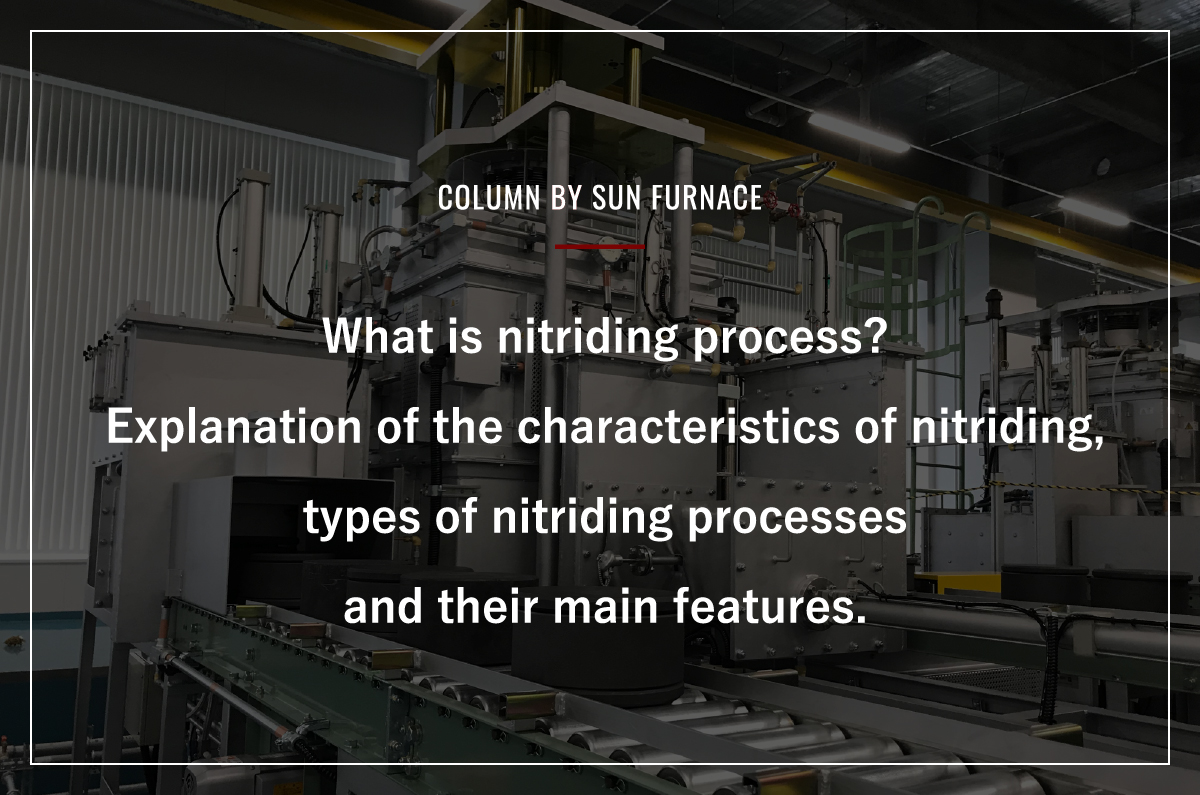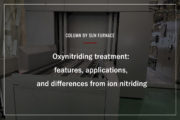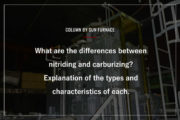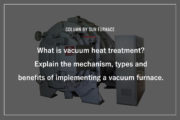We have designed and manufactured over 1500 industrial furnaces, catering to various industries such as automotive, steel, and chemical. With extensive experience and a proven track record in a wide range of furnace types, we offer a diverse range of solutions. In addition to industrial furnaces, we provide total support for related equipment and conveyors, and have successfully tackled a multitude of challenges based on different specifications and needs.
What is nitriding process? Explanation of the characteristics of nitriding, types of nitriding processes and their main features.

Nitriding treatment is widely used in various machine components that are present in our daily lives, ranging from appliances and automobiles to industrial machinery.
This process helps to increase the surface hardness of metals, thereby improving wear resistance and enhancing corrosion resistance for long-term durability.
A distinct advantage of nitriding is its ability to minimize metal distortion due to its relatively lower processing temperature compared to other heat treatments.
In this article, we will delve into the essence of nitriding treatment, explaining its characteristics, various methods and practical applications. We will also shed light on the field of specialized nitriding techniques.
目次
What is nitriding process
Nitriding is one of the heat treatment processes for steel that is widely used in various industrial products, along with processes such as quenching and carburizing.
The choice of heat treatment depends on the characteristics of the material, the intended use and environmental factors.
Nitriding involves heating in a nitrogen atmosphere to form nitrides on the steel surface, thereby increasing its hardness.
This process was developed by Dr. A. Fry of the German Krupp Company in 1923, and various techniques have since been researched and developed for specific applications.
The treatment temperature, which is relatively low (400 to 600℃), reduces the risk of deformation of the treated material.
In addition, the treated surface achieves a hardness in excess of HV1200 on the Vickers scale, which improves wear resistance.
The nitriding treatment also improves corrosion resistance and provides durability, making it suitable for components that require longevity due to its resistance to aging.
On the other hand, the hardened layer produced by nitriding is shallow, ranging from 0.1 to 0.5 mm from the surface. This makes it unsuitable for heavy-duty applications, so careful consideration of the intended use is required.
Difference from carburizing
In addition to nitriding, another common heat treatment for steel is carburizing.
Both methods involve heating the surface of the steel for processing. However, in carburizing, carbon is diffused and infiltrated into the structure of the steel surface, while in nitriding, nitrogen is diffused and infiltrated into the surface structure.
Nitriding only hardens the surface structure, leaving the internal structure unaffected, which helps maintain the toughness of the material.
Both methods increase the hardness of the steel surface, resulting in improved wear resistance, making them suitable for components that are exposed to continuous friction, such as engine parts in automobiles and bearings in machinery.
However, due to differences in surface hardness and dimensional accuracy, it’s important to select the appropriate treatment method based on the component’s intended application.
The main difference between nitriding and carburizing is the heating temperature.
Nitriding is performed at temperatures between 400 and 600℃, whereas carburizing is performed at higher temperatures, typically between 850 and 1050℃.
Nitriding is characterized by its low temperature heating, which results in minimal dimensional changes. However, due to the shallow depth of the hardened layer, which is only about 0.1 mm, it is unsuitable for components subjected to significant impact.
These properties are exploited in the manufacture of components such as engine cylinders, pumps and compressor parts.
Carburizing, due to its high temperature nature, results in a deeper effective hardened layer and superior impact resistance compared to nitriding.
In addition, the improved toughness results in improved fatigue properties, making it suitable for repetitively stressed components such as engine and clutch parts and machine bearings.
However, the high-temperature heating process during carburizing can cause material deformation, making it unsuitable for components requiring strict dimensional accuracy.
Comparison of nitriding and carburizing characteristics
| Effective hardened layer [mm] |
Hardness [HV] |
Distortion | |||
| Nitriding | 0.1~0.5 | Shallow | 1000 | Hard | Small |
| Carburizing | 0.5~2.0 | Deep | 620~780 | Soft | Large |
| Carburizing-Nitriding | 0.5~2.0 | Deep | 1000 | Hard | Small |
| Nitrocarburizing | 0.1~0.5 or more | Deeper than Nitriding Deep | 700~800 | Harder than carburizing | Small |
Types of nitriding processes and their respective caracteristics.
There are several types of nitriding processes based on the treatment method.
- Gas nitriding
- Salt bath nitriding
- Plasma nitriding
- Gas soft nitriding
- Liquid nitriding
- Sulfur-based nitriding
- Nitrocarburizing
Each process has different criteria based on suitable materials and treatment times. Here are the main characteristics and values for each process.
| Nitriding methods | Treatment temperature [℃] |
Hardness [HV] |
Effective hardened layer depth [μm] |
Applicable steel types |
| Gas nitriding | 510 (400) |
1000 | 100 | High-grade steel (Stainless steel、Nickel steel) |
| Salt bath nitriding | 570 | 500 – 600 | 20 | Structural steel Stainless steel Tool steel |
| Plasma nitriding | 400 – 570 | 1000 | 10 | Stainless steel Titanium material |
| Gas soft nitriding | 500 – 580 | 500 – 600 | 100 | Low-grade steel |
| Liquid nitriding | 500 – 570 | 600 – 650 | – | Carbon steel |
| Sulfur-based nitriding | 570 | 400 – 550 | 100 | Carbon steel Alloy steel |
| Nitrocarburizing | 750 | 700 | 200 | Low-grade steel |
*Low-temperature (400℃) treatment
Next, we will explain the characteristics of each nitriding method one by one.
Gas nitriding
Gas nitriding is a nitriding process that uses ammonia gas in an atmosphere gas. Ammonia gas is decomposed into hydrogen and nitrogen by thermal decomposition and then used.
During this process, nitrogen infiltrates the surface of the steel and forms a hardened layer.
The highest hardness is achieved at a heat treatment temperature of about 500℃, and the surface hardness reaches about HV1000 at a depth of about 0.1 mm.
Above 520℃, a brittle white layer becomes thicker, leading to a reduction in surface hardness. For this reason, gas nitriding is usually performed at 510℃.
There is also a process that involves treatment at a lower temperature of about 400℃ compared to conventional gas nitriding.
In low-temperature nitriding, the rate of nitrogen infiltration and diffusion is slower than in the conventional process, resulting in minimal deformation of the metal.
However, it’s important to note that the treatment time is longer.
In addition, this process typically offers a wider range of steel types compared to regular gas nitriding. This feature allows for a wider range of applications, including stainless steels and nickel steels.
Advantages of low-temperature nitriding
- Wide range of applicable steel types
| Temperature | Steel types | |
| Low-temperature gas nitriding | Approximately 400℃ | Carbon steel,Alloy steel,Stainless steel,Nickel steel |
| Gas nitriding | Approximately 510℃ | Carbon steel,Alloy steel |
- The hardness depth is not affected by the surface shape and remains stable.
- The surface compound layer (white layer), which is the nitride layer, can be adjusted.
- Cooling takes place inside the furnace, resulting in minimal thermal distortion.
- There is minimal deterioration in corrosion resistance and wear resistance is improved.
Salt bath nitriding
Salt bath nitriding is a process that involves immersion in a salt bath at a temperature of approximately 570°C for a duration of 30 to 180 minutes.
The salt bath contains primarily cyanide salts (KCNO, NaCNO) for treatment, resulting in simultaneous nitriding and carburizing.
This unique feature allows nitriding of austenitic stainless steels that cannot be achieved with gas nitriding.
A white compound layer of iron and nitrogen, approximately 20μm thick, forms on the surface of the hardened layer, resulting in improved wear and corrosion resistance.
For example, the hardness of SKD61 material can exceed HV1000.
Underneath, at a depth of about 0.5 mm, a diffusion layer of nitrogen forms with a hardness of about HV500.
This differs from other nitriding treatments in that it forms as a compound layer rather than a nitrogen diffusion layer.
Plasma nitriding
In plasma nitriding, several hundred volts of direct current are applied to the furnace body and the workpiece, which serve as the anode and cathode, respectively. During the glow discharge, ionized nitrogen is directed toward the workpiece, allowing nitrogen to infiltrate and diffuse into the workpiece.
The nitrogen ions and hydrogen ions generated by the glow discharge repeatedly collide with the surface of the workpiece, resulting in a nitriding treatment.
Plasma nitriding increases the hardness of the surface by more than HV1000 to a depth of 20μm.
Plasma nitriding has the advantages of short processing time, low temperature processing with minimal deformation, and lower environmental impact compared to gas nitriding or salt bath nitriding.
Gas soft nitriding
Gas soft nitriding is a process that involves treatment with a mixed gas of endothermic reactive gas (RX gas) and ammonia gas, or a mixed gas of nitrogen and carbon dioxide and ammonia gas.
Compared with the typical heat treatment temperature of about 900℃, the processing temperature of gas soft nitriding is low (about 500-580℃), resulting in less susceptibility to distortion.
The surface hardness reaches HV500-600 at a depth of 0.1mm, allowing for improved wear resistance and fatigue strength.
Due to the lower processing temperature compared to other heat treatments, dimensional changes are minimized and the formation of oxide films is less likely, contributing to an attractive appearance.
In addition, gas soft nitriding can be applied to a wide range of steel types, from low-carbon steel to high-alloy steel, which distinguishes it from conventional gas nitriding.
Features of gas nitriding and gas soft nitriding
| Gas nitriding | Gas soft nitriding | |
| Atmosphere gas | Ammonia gas | Mixed gas (Ammonia gas,Carburizing gas) |
| Applicable steel types | High-grade steel | Low-grade steel |
| Surface hardness | High | Low |
| Hardening layer | Deep | Shallow |
| Processing time | Long | Short |
| Processing temperature | Low | High |
Gas nitriding takes time to produce a nitriding layer at a low processing temperature, but results in high hardness.
On the other hand, gas soft nitriding can be done in a shorter time, but while the surface contains a compound layer with nitrogen, the diffusion layer inside contains carbon. As a result, the hardness decreases as you go deeper into the material.
The choice between the two depends on the intended finishing application.
Nitrocarburizing
Nitrocarburizing is a type of gas nitriding that involves processing in an atmosphere mixed with oxidizing gases containing air, carbon dioxide, or moisture added to an ammonia gas environment.
This process takes place at temperatures between 500℃ and 570℃ for several hours. It facilitates the simultaneous diffusion and penetration of nitrogen and oxygen onto the surface of the steel material.
The top layer on the surface of the steel material is called the nitrocarburizing layer, while a nitriding layer dispersed with nitrogen is formed underneath. Together, these layers are called composite layers. The surface nitrocarburizing layer has properties such as wear resistance, corrosion resistance, and resistance to sticking and fatigue.
Sulfur nitrocarburizing
Sulfur-nitrocarburizing is a treatment method that forms a layer called “sulfur-nitrocarburizing layer” by diffusing nitrogen and sulfur into the surface of steel.
This process improves wear resistance and anti-stick properties. Due to its short processing time, it is used as a rapid nitriding treatment and achieves a surface hardness of HV400 at a depth of 30 to 50 μm for S45C steel.
There are two main methods of sulfur nitrocarburizing: salt bath sulfur nitrocarburizing and gas sulfur nitrocarburizing.
In salt bath nitriding, the workpiece is immersed in a nitriding salt bath containing sulfur salts at a temperature of 570℃ for several hours.
This results in the formation of a porous sulfur nitrocarburizing layer with coexisting sulfur and nitrogen on the steel surface.
Gas sulfur nitrocarburizing, on the other hand, takes place in a gas atmosphere rather than a salt bath.
A small amount of hydrogen sulfide is added to ammonia gas to form the sulfur-nitrocarburizing layer on the steel surface.
Since atmosphere gases containing hydrogen sulfide are hazardous, the installation of exhaust gas treatment equipment is required.
Nitriding quenching
Nitriding quenching is a metal surface treatment that involves the diffusion and permeation of nitrogen into the steel surface, followed by a unique quenching process that is unusual for nitriding treatments. This results in the formation of a hard quenched layer.
The layer formed is called nitrogen martensite, which is effective in improving wear resistance and fatigue strength.
A notable aspect of this technique is that the transformation temperature of steel with nitrogen is lower than that of carbon. As a result, the processing temperature for nitriding quenching is lower than that for carburizing quenching. In addition, this process results in minimal distortion due to heat treatment and provides hardness similar to that of carburizing quenching.
Special nitriding treatment techniques
Let’s look at two special nitriding techniques. They are based on the nitriding methods discussed earlier:
NV nitriding
CR-NITE treatment
NV Nitriding
NV Nitriding is a unique nitriding process developed by Air Water NV Inc that combines gas nitriding with gas activation (fluoridation) treatment.
The gas activation treatment removes the oxide film formed on the metal surface and replaces it with a fluorine film.
If the gas activation treatment is performed before the gas nitriding treatment, nitrogen can easily penetrate the metal surface.
Therefore, by applying gas activation pretreatment, NV nitriding offers the following advantages over conventional gas nitriding treatment
- Broad applicability to various types of steel
Nitriding treatment can be applied to a wide range of steel types, including carbon steel, stainless steel, sintered materials and nickel-based alloys. - Processing in a wide temperature range from mid-300℃ to 600℃
This capability accommodates conditions that require minimizing distortion in the metal and increasing surface hardness to meet specific requirements. - Atmosphere control allows for low nitrogen potential treatment
Atmosphere control allows for various modifications such as compound layer-free treatments, depth control, and hardness adjustment. - Customization of the nitriding layer for different applications
Customization of the nitriding layer is possible based on specific applications. For example, the hardness required for specific applications such as “forging dies” can be designed.
Additionally, NV Nitriding is utilized in a wide range of industries and sectors for various components:
- Motorcycles, automobiles, and construction machinery (turbocharger components, engine valves, steel belts, etc.)
- Industrial machinery (bearing components, textile machinery)
- Home appliances (air conditioning, food machinery components)
- Molds (die casting, forging)
- Food industry (cooking utensils, tableware, kitchenware)
- Medical and care equipment, etc.
More detailed explanations can be found on this website.

CR-NITE Treatment
CR-NITE treatment is a process that forms a uniform chromium nitride layer on a metal surface that has already been nitrided.
This is achieved by introducing gaseous chromium components to the metal surface after the NV nitriding treatment, which react with the nitrogen in the nitride layer to form a chromium nitride layer on the surface. This is Air Water NV’s proprietary surface treatment technology (Patent No. 6637231).
The CR-NITE treatment provides
- Significantly improved wear resistance compared to nitriding
The uniform nitride layer formed by NV’s nitriding treatment reacts with chromium to form a high-hardness chromium-nitride layer with a maximum hardness of MHV1800. - Exhibits high-temperature oxidation resistance beyond that of heat-resisting alloys
Can be used in oxidizing atmospheres at temperatures exceeding 1000℃ for common stainless steels. - Demonstrates high corrosion resistance
Corrosion tests in salt spray and acid solutions confirm corrosion resistance similar to that of stainless steel. Thus, it is adaptable for both corrosion resistance and wear resistance.
Metal surfaces treated with CR-NITE exhibit a highly resistant chromium nitride layer approximately 20 microns thick, along with a chromium diffusion layer approximately 20 microns deep underneath.
Materials treated with CR-NITE maintain stable performance over long periods of time in harsh environments.
For example, valve components used in the harsh conditions of power plants showed no significant cross-sectional changes even after extended use. This indicates the ability to maintain stable and reliable performance over time, especially in environments where high reliability is critical.
More detailed explanations can be found on this website.

Frequently Asked Questions:
Q:What is the difference between nitriding and soft nitriding?
Soft nitriding was developed as a technique to allow nitriding treatment in a short period of time.
While it increases the processing temperature and reduces the processing time, the trade-off is that the depth of the hardened layer becomes shallower.
It’s used for parts such as consumer electronics and certain automotive components where relatively low hardness is required.
Q:Can carburizing and nitriding be done simultaneously?
There is a process known as “carburizing-nitriding quenching” where carburizing and nitriding treatments are performed simultaneously.
This can be done when both the surface hardness from nitriding and the depth of the carburized hardened layer are required.
While surface hardening by carburizing can lead to distortion, hardness and depth can be balanced.
This process is used for components such as hinges in car doors.
Q:What should be considered when changing from quenching to nitriding?
Nitriding has the advantage of minimal dimensional change compared to quenching. However, there’s a possibility that the effective hardened layer may be shallower.
Also, properties such as wear resistance and impact resistance may change. Therefore, careful consideration is required, taking into account the application environment and purpose of the product.
It’s recommended to conduct heat treatment tests and quality evaluation in advance.
Summary
Throughout this discussion, we’ve covered the characteristics of nitriding, the differences between nitriding and carburizing, and the different types of nitriding treatments along with their individual characteristics.
Nitriding offers the advantage of minimal metal deformation due to its lower processing temperature compared to carburizing and quenching treatments.
It not only improves surface hardness and wear resistance, but also provides sustained corrosion resistance that can help mitigate the effects of aging.
The different types of nitriding treatments offer different approaches, and the selection should be based on the product’s operating environment and intended use.
In addition, when standard nitriding treatments don’t meet product specifications, specialized methods such as NV nitriding or CR-NITE treatment can be selected.
If you are faced with challenges related to surface treatment of metal products, don’t hesitate to consult a specialized heat treatment manufacturer for guidance.
Industrial furnace manufacturer, Sun Furnace, proposes custom-made atmosphere gas generation devices tailored to your application based on the know-how gained from manufacturing more than 1,500 industrial furnaces.
We also offer free technical consultations, so please feel free to contact us.
Explore Sun Furnace’s atmosphere furnace in detail
Take a closer look at Sun Furnace’s rotary kiln




